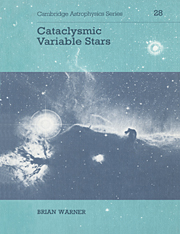2 - Structure of Non-Magnetic Systems
Published online by Cambridge University Press: 23 December 2009
Summary
….duplicity with honour.
Saul Bellow. Humboldt's Gift.Two stars keep not their motion in one sphere.
William Shakespeare. King Henry IV, Part I.It is probable that magnetic fields play a role in all CVs – even in nominally nonmagnetic systems by driving orbital evolution through magnetic braking (Section 9.1.2.1) or in providing the source of viscosity in accretion discs (Section 2.5.2.2). However, in systems where the primary has a relatively weak magnetic field (105 G) the movement of gas from the secondary to the primary is determined predominantly by dynamical and hydrodynamical flows.
This chapter provides an overview of how the physical properties of the various components in non-magnetic CVs can be treated theoretically and deduced observationally.
Classification of CVs
The present system of assigning individual CVs to specific types is a simplification of earlier, more detailed schemes that were developed in response to the steadily revealed diversity of CV behaviour. All early classifications were based on morphology of light curve. The distinction between novae and DN was maintained until the discovery of RN and the later realization that the recurrence times and outburst ranges of RN and DN overlap. Then appeal to their different spectroscopic characteristics became necessary.
Detailed properties of the subtypes that exist among the CN, DN, RN, NL and magnetic CV classifications are given in the respective chapters. For the purpose of this chapter, which examines the underlying binary and accretion disc structure common to all non-strongly-magnetic CVs, it is necessary only to expand a little on the types already introduced in the first chapter.
- Type
- Chapter
- Information
- Cataclysmic Variable Stars , pp. 27 - 125Publisher: Cambridge University PressPrint publication year: 1995
- 4
- Cited by

